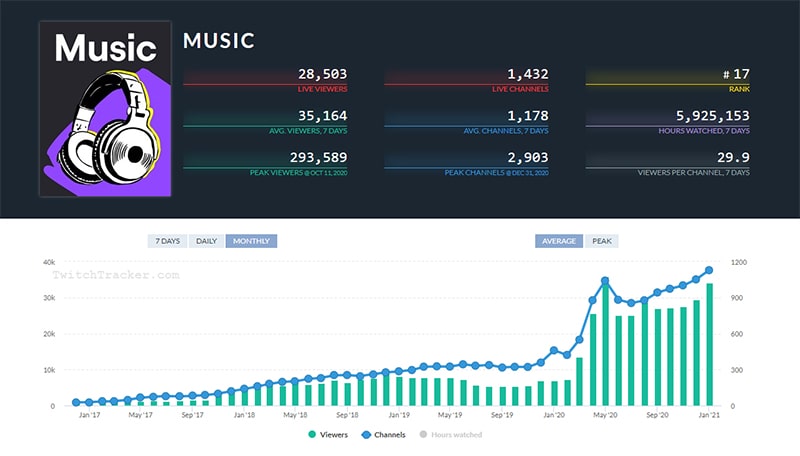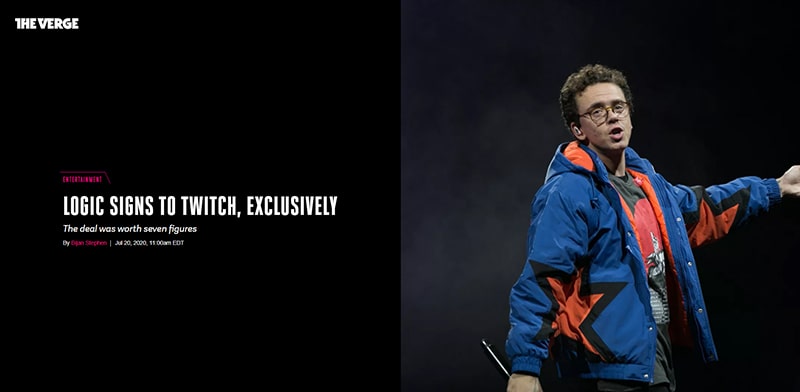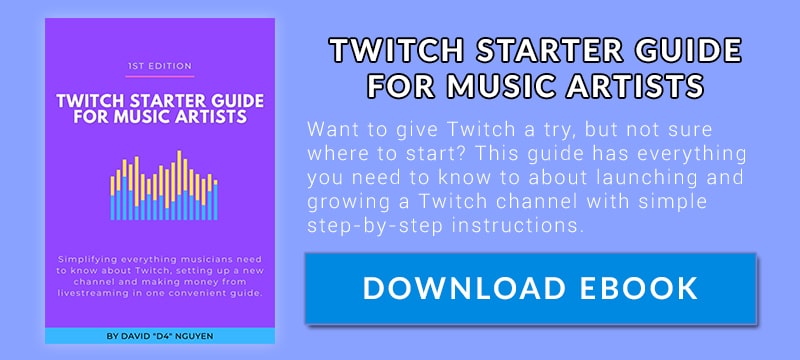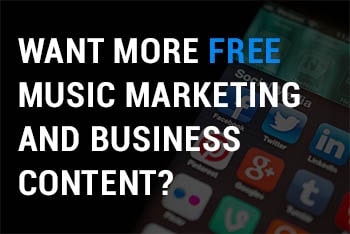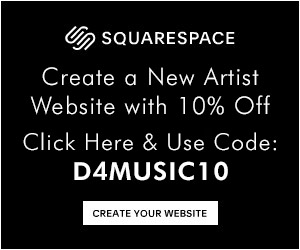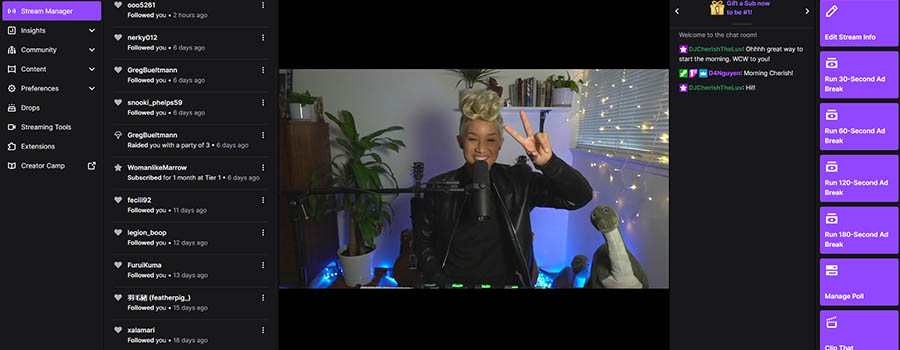
This is a preview of my new eBook “Twitch Starter Guide for Music Artists.” I’m sharing the first few introductory chapters that provide more of an overview of Twitch and how to make money on the platform as it pertains to musicians. For detailed guidance and instructions on how to start your Twitch channel, grow your audience and enhance your livestream experiences, you can purchase my full eBook here. I have a special introductory offer for the 1st edition so save time and money by getting a copy today.
Introduction
With over 15 million daily active users, Twitch is the most popular live streaming platform out there. One of the fastest-growing categories on Twitch is Music & Performing Arts, which currently has over 3 million followers. Before the COVID-19 pandemic took off in March of 2020, viewership for this category went up from 6,000 concurrent viewers a day to over 30,000! Now, music actually has its own category tab on the top of the home screen.
In July 2020, Twitch signed artist Logic to an exclusive 7-figure deal, a first of its kind for a musician. To me, this is a sign that they really want to attract more music fans to their platform. Whether you’re a singer-songwriter, rapper, band, drummer, violinist, DJ or producer, there’s opportunity for every type of musician on Twitch.
You don’t have to be a well-known touring artist to take advantage of Twitch’s growth in the music category. You should consider even if you aren’t an established act that gets booked for paid gigs regularly. Because Twitch for music artists is still a growing category, it’s an exciting opportunity for you to take advantage of. Who knows when or how soon the live performance sector will bounce back, especially with a lot of smaller venues facing closures due to the pandemic.
The big question is, how do you get started? Starting on a new platform like Twitch can be intimidating and confusing. Even as a tech-savvy person myself, it took me a while to get a feel for everything and understand how it works. The tough part is knowing how to get everything set up correctly.
This blog is a preview of my eBook that provides an overview of Twitch and how to make money on their platform as a musician. I go into much more detail in my “Twitch Starter Guide for Music Artist” where I share everything you need to know about getting started with livestreaming on Twitch. Because it’s a starter guide, I wanted to make it as clear and easy as possible for you to understand the platform and how to get set up properly without getting lost.
What is Twitch?
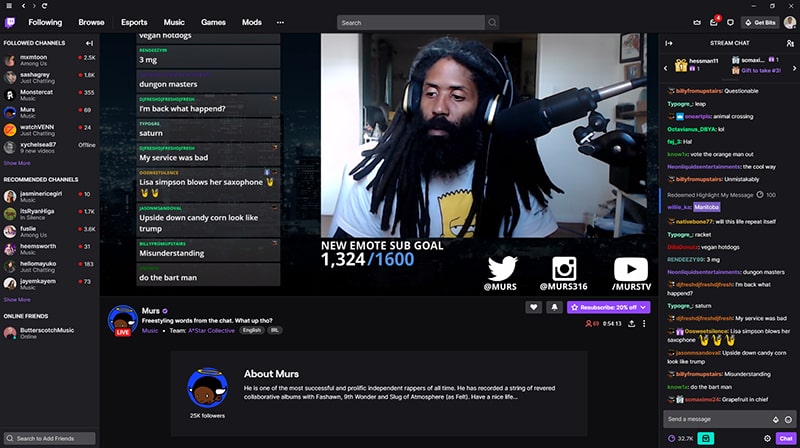
Founded in 2011, Twitch is a free-to-watch livestream video platform owned by Amazon. For me, it feels like a live television platform where you can tune into anyone’s channel or create your own. Just as YouTube is the king of prerecorded video on the internet, Twitch is the king of livestreaming video.
Twitch is predominantly known for hosting video game livestreams, at least that’s how it started out. Now, they host all types of other content like music, live art, wood carving, travel, cooking, and fitness. Thanks to COVID-19, these other categories have expanded much quicker out of necessity.
What makes Twitch different is that it tends to be long-form content. Musicians are typically on for over 2 – 3 hours, while some musicians go even longer on a regular basis a few times a week.
It is highly community-driven so you definitely should have that mindset coming into it. As a live streamer, you should see yourself more as a community builder and entertainer rather than just an “artist.”
Where does Twitch fit in an artist’s business model?
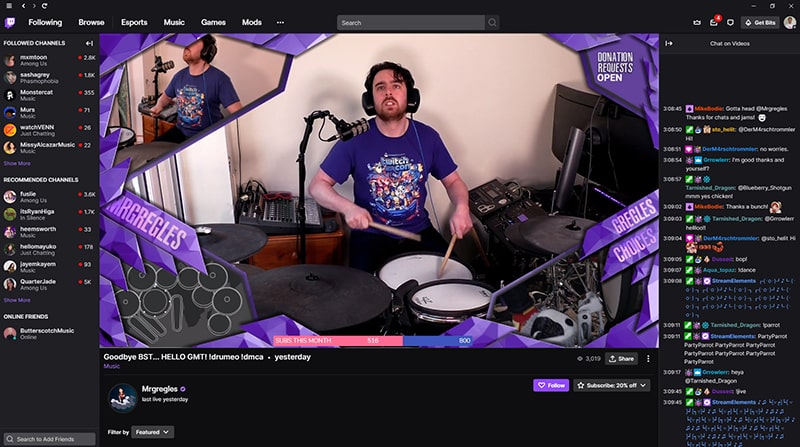
Livestreaming has been around for quite some time, but it was never a core part of a musician’s business model or served as a revenue-generating function. When it was used by artists, it was often a complementary component or a marketing arm to help develop an artist brand, engage with fans or promote a new project/product. Making money with livestreaming wasn’t the focus as there wasn’t a way to do it seamlessly and you had in-person shows that could pay more.
In the earlier days of platforms like Facebook Live and Instagram Live, you would include a link to PayPal to accept tips or mention your user handle on video to a payment app like Venmo. It resembled busking on the streets, but on social media. You would hear about success stories here and there, but it was never taken seriously as a way to sustain a music career.
Things have changed the past few years as platforms like Twitch have incorporated ways creators can earn money from their livestreams like how YouTube pays creators who upload video content to their platform. Viewers/fans not only give tips but also purchase a paid subscription and become members of a creator’s community.
It wasn’t until the COVID-19 pandemic hit, shutting down live shows and events, that accelerated interest in livestreaming to generate recurring income.
Twitch falls into what I would call a subscription/membership-based model, which has been growing as a sustainable income option for musicians over the years, similarly with platforms like Patreon. It is structured to be more of a core centerpiece to what you do as a musician and how you monetize sustainably.
A livestreaming model based on Twitch can be used as a part of your business model, but it may hinder your progress if you’re not able to maintain some level of consistency once you reach a certain level.
In other words, Twitch is not something you want to treat like Instagram Live where you go live whenever you feel like it. You need to approach it as if you are developing a TV channel with your own programming and live stream schedule. Once you’ve grown your subscriber base, you’re expected to go live on a regular basis.
You should be aware that Twitch’s main competitors, Facebook and YouTube, are also structuring their livestreaming and monetization features similarly to Twitch. YouTube has offered ad share monetization for its creators and launched channel memberships in 2018 with similar perks that Twitch has. Facebook has also followed suit to offer the same type of income streams for live streamers on their platform.
If you already have a following or subscribers on those platforms, you may find this route more attractive. However, the community on Twitch should not be underestimated. After all, Twitch is the most popular livestreaming platform out there.
How to Monetize on Twitch
The big question you are probably wondering is how to make money on Twitch. Unlike going live on Instagram, Twitch has monetization built into the platform to allow creators to get paid for their content in a number of ways. There are also other income streams that can be incorporated outside their system.
One of the big strengths of Twitch as a live streaming platform is how monetization is more integrated than others. Anyone can tune in and watch for free so there’s no paywall or barriers to access your content.
Here are the top 7 ways to generate income with your Twitch channel.
1. Ad Revenue
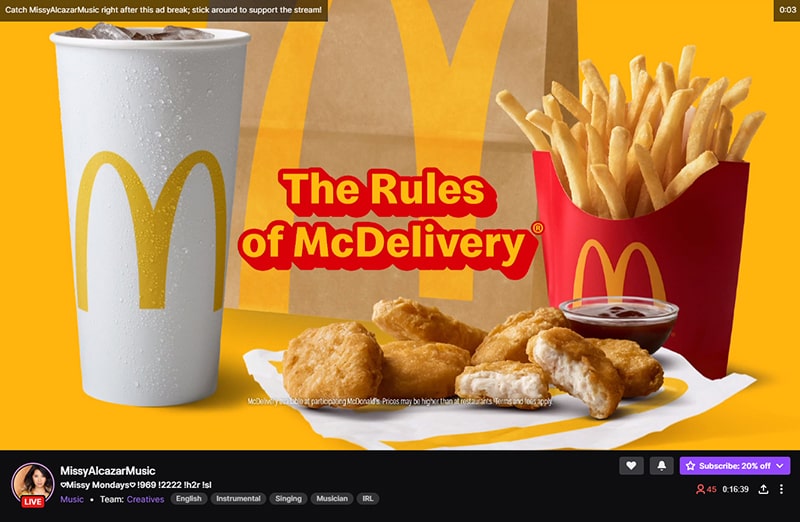
When you first tune into someone’s Twitch channel, chances are there will be an ad that plays before the viewer sees the livestream. This is a pre-roll ad and the streamer gets a cut of this ad revenue. You have to have an affiliate or partner status to host ads and a share of the ad revenue from running ads on your channel.
As a creator, you also have the ability to press a button during your stream to display an ad during your broadcast, which you get paid for. This is called an ad break. It is usually done when the streamer is stepping away from the keyboard to use the restroom for example. All your viewers will see it and you get paid for each impression.
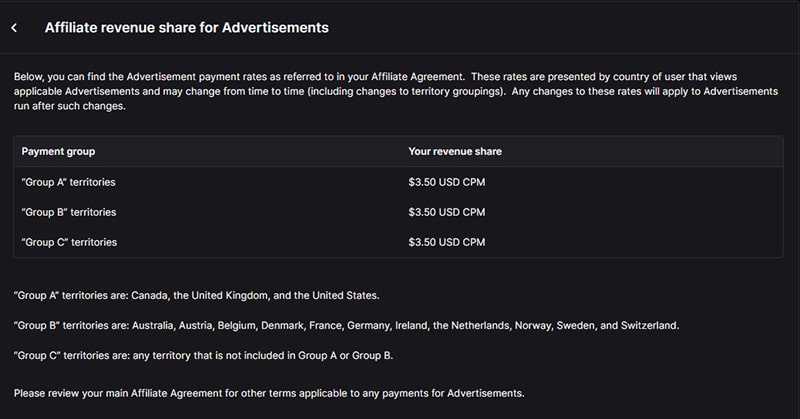
When you become an affiliate, you’re looking to get paid about $3.50 US for 1,000 views. Twitch pays you a flat-rate CPM (cost per mille or cost per 1000 views) that will vary depending on the time of year.
The neat thing is you have control over when to play ads and for how long during your stream. It’s up to you how many times you want to serve ads to your viewers and get paid for it.
2. Channel Subscriptions
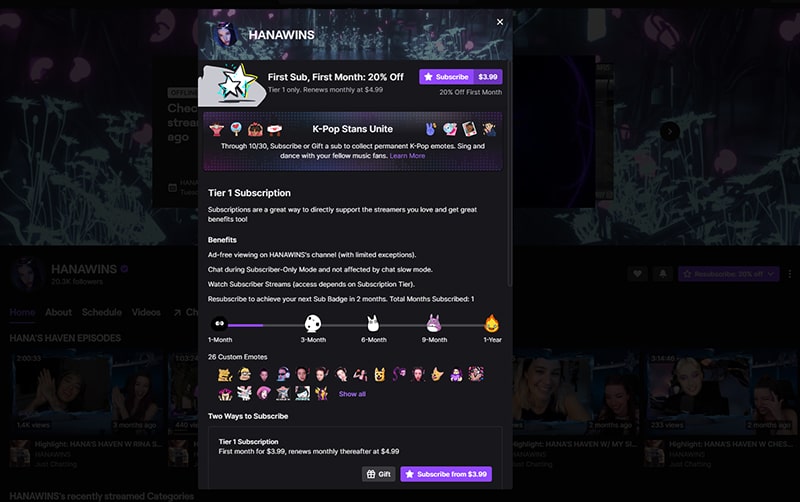
Viewers can subscribe (subs for short) to your channel or gift subs to other viewers watching you. This gives creators a form of recurring monthly income. In order to be eligible to offer subs, you need to have affiliate or partner status on Twitch. You can then customize what kind of perks you offer to subscribers, like ad-free viewing of your live streams and chat features.
There are 3 subscription tiers with different perks – $4.99, $9.99 and $24.99.
Twitch splits subscription income 50/50 with you. If you’re a top tier creator, you get 70% while they get 30%.
For those who pay for Amazon Prime membership, you have what’s called Prime Gaming (formerly known as Twitch Prime) which gives you a free sub for any creator each month. For Twitch Prime subs, creators still get half of a $4.99 sub.
3. Virtual Money (Bits)
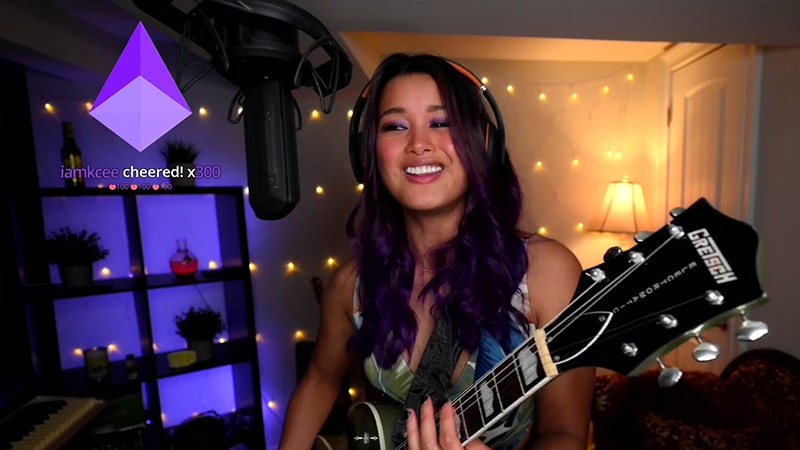
Rachel Lily receiving a cheer (bits) during her stream.
Twitch sells a virtual currency called “bits” that viewers can purchase to donate to streamers. Bits allow viewers to buy cheers (short animations that pop up on the livestream) to show support. It’s essentially a fun way of tipping or donating to a creator.
The cost of bits will vary depending on how much you buy. There is a discount when you buy a larger amount. At the base level, it costs $1.40 to buy 100 bits. Streamers make about 1 cent per bit.

Read a more in-depth guide on bits here.
4. Sponsorships / Brand Deals
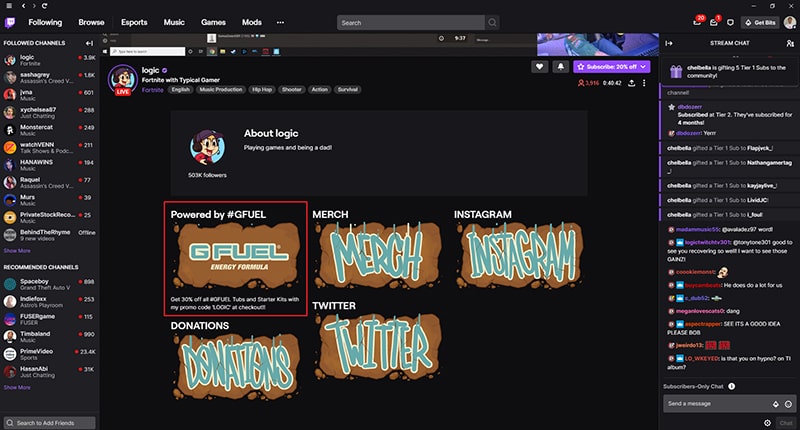
Logic’s brand deal with G Fuel
Once you have a larger following on Twitch, you become a more lucrative target for companies to approach you about promoting their brand or products to your viewers. They may want to pay you to do or say something on a specific stream. Or it can be a long term partnership with your channel.
For example, a music instrument company might want to sponsor you and pay you to use their drum kit or guitar on stream with their logo visible.
Sponsorships for artists don’t have to be limited to music. It can be companies related to livestreaming like computer hardware, cameras or electronic retailers. Basically, any company that wants to reach your specific demographic or audience based on how aligned your brand is to theirs.
How much you can get paid is going to be negotiated based on a number of factors, like your audience size, brand alignment and the type of engagement you have.
5. Tips / Donations
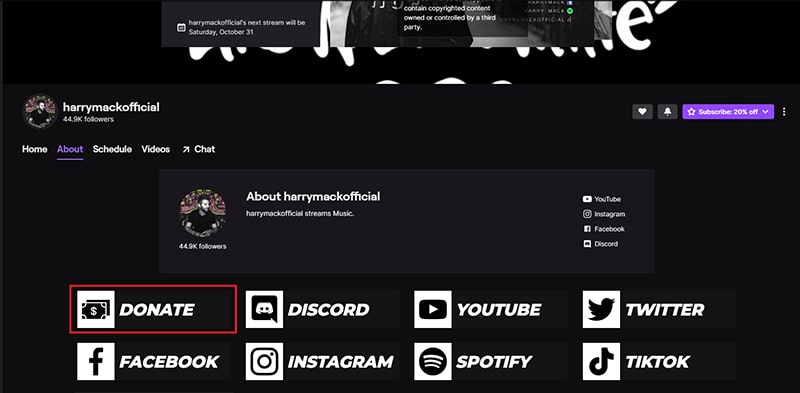

You can also receive your standard tip and donation from viewers through different services like PayPal, which is the most common one. Twitch does not take a cut, but you will usually pay some credit card processing fee from the payment company.
There are some risks involved with accepting tips this way like fraud and chargebacks. More on this will be discussed below in a later section.
6. Affiliate Links
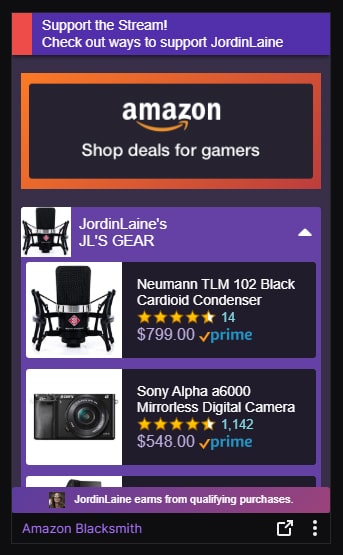
Example of affiliate links you would see on a Twitch channel.
You can host affiliate links where you receive a small commission when a purchase is made using your link. Oftentimes, the links are for the live stream gear or music equipment you use during your live stream so your viewers can buy it.
The most common affiliate partner is Amazon. After all, they own Twitch. You can learn more about Amazon’s affiliate program here.
7. Merch

Lastly, you have your traditional merch sales. This is obviously not exclusive to Twitch, but offering merch like tees and hats are a common way fans like to support any creator.
You can easily host a link to your online store or any other storefront that you have merch for sale on your about page. The best way to promote merch is to do it during your live stream by wearing it or showing it off to viewers.
Is Twitch right for you?
As much potential as there is with Twitch for music artists, it is not for everyone. I don’t want to give anyone the impression that this is some “get rich and famous quick” shortcut to music stardom. In fact, this may be a more challenging route than a “conventional” music career due to the fact that Twitch is not commonly associated with the typical music ecosystem – like Instagram, YouTube, SoundCloud, Facebook and Spotify.
To be fair, building your presence and following on any platform is going to take time, hard work and patience. It’s no different anywhere else, but it’s up to you to figure out if livestreaming on Twitch is something that you enjoy and plays to your strengths as an artist/performer.
With the growth of Twitch as a staple for livestream content, just know that there is an opportunity for musicians to take advantage. Generating money is always going to be the biggest challenge when trying to build a career around music, but Twitch is able to integrate many sources into one place.
It’s important to note that livestreaming on Twitch is not just about performing music and playing video games, it’s about knowing how to build a community, engage with viewers in real-time and entertain. Also, there’s a level of transparency and openness that you need to feel comfortable with. You don’t have to be a social or extroverted person, as some of the streamers I watch are self-identified introverts. Don’t think you have to be a certain way to find success on the platform.
Brand new to Twitch? I highly suggest you start by spending some time on the platform and watch other creators of all types to see how they engage with their audience.
If Twitch is an avenue you would like to explore as a potential income source, I highly recommend checking out my eBook. There’s plenty of information and guides scattered around the internet you can get for free, but I save you a lot of time by curating all that information into one convenient guide. After all, it can be confusing and overwhelming starting on a new platform you’re not familiar with.
In my eBook, I break everything down for you where you’ll learn:
- How Twitch works as a platform
- The different monetization sources you can earn as a livestreamer
- How to setup your Twitch channel
- A breakdown of the hardware and software you need
- Livestream content ideas and Twitch channel recommendations
- The different streaming tools and channel upgrades to enhance your livestream experience
- How to grow your channel and get more viewers



